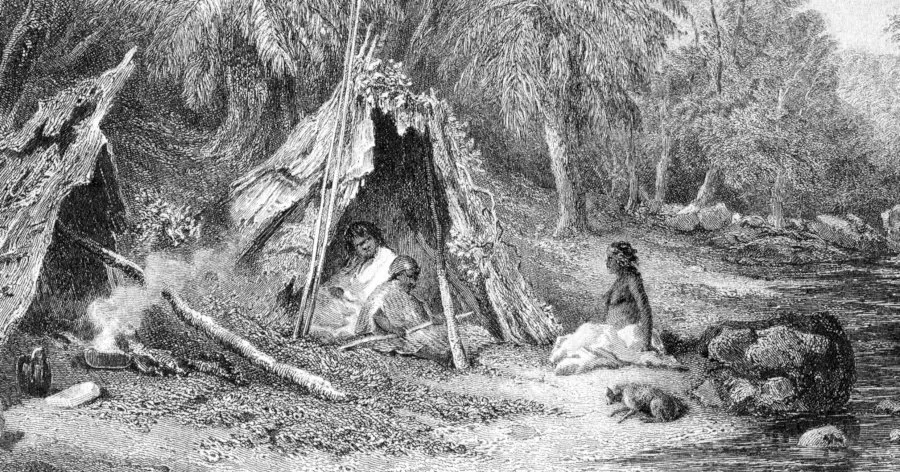Before we learned about farming and started settling down in villages and cities, before the "sapiens" variant of our species walked the earth, we survived as hunter gatherers for hundreds of thousands of years.

source: Wikipedia
Imagine, if you will, what life must have been like back then, with us knowing next to nothing, not having any technology at all, wondering about where lightning comes from and drawing figures in the sky by connecting the tiny white dots across the night-sky to form all sorts of animals and other things found in nature. What would the world look like in those ancient eyes? Well, let's explore that for a moment, and see if we can learn something from these most distant ancestors of ours.
Let me share with you some words from Carl Sagan, talking about a now extinct band of hunter gatherers that lived in central Africa up until four or five decades ago. He describes the actions of a hunting party;
"They come near a stand of trees. They take one close look at the ground. Immediately they know how many animals went by, what their ages and sexes were, how long ago they passed, 'this one is lame in the back left foot', at the pace they're going, we should be able to overtake them in another two hours, if we hurry... Now how do they know all that? In fact, what do they notice in order to follow the game on which their lifes prety well depend?"
He then goes on to describe how they are able to read the most intricate details of every trace left behind; of course there's the obvious observations that every animal leaves a different footprint, larger specimens leave larger, and heavier specimens leave deeper prints. But then there's the amount in which the small ridge around the print has eroded, how much has the print been filled by debris falling in afterward; this gives an indication about the time passed. Sagan even compares this with the study of planetary surfaces where the "freshness" of impact craters is used to determine the age of both the impact and the planetary surface itself.

Image by Woodlouse - source: Flickr
The hunters know, courtesy of many generations of experience, that herd-animals in the hot sun like to deviate from their course when there's some shadow in sight; they'll gladly make a slight detour if that allows them to briefly run in the shadow instead of the blazing sun. Our hunter gatherers know where the sun must have been in the sky for the shadows to fall on the path taken; another tell-tale sign of the time the animals passed that location; the moving celestial bodies have acted as our private giant clock for at least hundreds of thousands of years. Their science was clear: the universe revolved around them, so they were in the center of It All; who can blame them for thinking that they must be very special, that the universe was there for them. The science was clear; everything revolved around us, the sun, moon and stars rise in the east and set in the west, to disappear into the mysterious underworld beneath the surface of the firm flat world that was put in the center of the universe, just for us...
The world must have looked amazing and threatening at the same time through those eyes; they didn't see the same world we would have seen if we were able to travel back to their time. Their eyes and their minds payed attention to nature in a way we can not anymore. Tribal Indians from the Amazon today see another jungle than we see if we visit them; it's been established in research that they're able to distinguish many shades of green and will never get lost because they can recognize individual trees, ferns, mosses and so on.
They were no strangers to technology either; it's a fine art to chisel a stone into a sharp-edged arrow-shape with only other stones as tools. They used poisoned arrows to, digging tools to make traps, carved notches on bones to keep track of something, time maybe. We, humans, have been scientists and technologists from the very beginning. If you want to learn more about our amazing ancestors and modern hunter gatherer societies, please watch this wonderful speech by Carl Sagan, called "The Age of Exploration":
Carl Sagan's 1994 "Lost" Lecture: The Age of Exploration
Thanks so much for visiting my blog and reading my posts dear reader, I appreciate that a lot :-) If you like my content, please consider leaving a comment, upvote or resteem. I'll be back here tomorrow and sincerely hope you'll join me. Until then, keep steeming!

Recent articles you might be interested in:
| Latest article >>>>>>>>>>> | (My) Atheism Explained |
|---|---|
| Universal Wasting Income? | Miracles Happen Every Day |
| Apple Pie From Scratch | Animated Exodus Extravaganza |
| Appeal To Common Sense | But It's True For Me! |

Thanks for stopping by and reading. If you really liked this content, if you disagree (or if you do agree), please leave a comment. Of course, upvotes, follows, resteems are all greatly appreciated, but nothing brings me and you more growth than sharing our ideas. It's what Steemit is made for!


Just for Full Disclosure, I'm invested in these crypto-currencies:
Bitcoin | Litecoin | EOS | OmiseGo | FunFair | KIN | Pillar | DENT | Polymath | XDCE | 0x | Decred | Ethereum | Carmel | XYO

@helpie is a WITNESS now! So please help @helpie help you by voting for us here!
